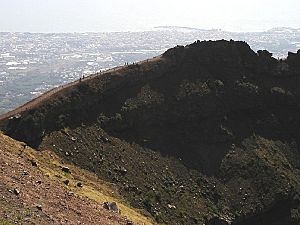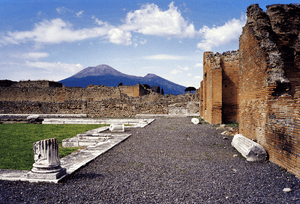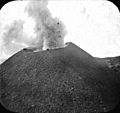Mount Vesuvius facts for kids
Mount Vesuvius (Italian: Monte Vesuvio) is a famous volcano in Italy. It is located near the city of Naples, right on the Gulf of Naples. Vesuvius is special because it's the only volcano on mainland Europe that has erupted in the last 100 years. Its last big eruption was in 1944.
Vesuvius is most famous for its huge eruption in AD 79. This powerful event completely destroyed the ancient Roman cities of Pompeii and Herculaneum. These cities were buried under ash and pumice (light volcanic rock). They were forgotten for many centuries until they were found again in the late 1700s.
The eruption also changed the land around the volcano. The Sarno River changed its path, and the coastline moved. This meant Pompeii was no longer near the river or the sea. Mount Vesuvius itself also changed a lot, losing many plants and having its top reshaped by the eruption.
Vesuvius has erupted many times since AD 79. Today, it is considered one of the most dangerous volcanoes in the world. This is because about 3 million people live very close to this explosive volcano. More people live near Mount Vesuvius than any other volcano on Earth.
Contents
What's in a Name?
The volcano was known by several names in ancient Roman times. People called it "Vesuvius," but also Vesaevus, Vesevus, Vesbius, and Vesvius. Ancient Greek writers called it "Οὐεσούιον" or "Οὐεσούιος".
Many experts believe the name Vesuvius might come from old words meaning "unquenchable" (meaning it can't be put out). Others think it could mean "hurling violence," which certainly fits a volcano!
How Vesuvius Looks

Mount Vesuvius has a large, main cone called Gran Cono. This cone sits partly inside a bigger, older caldera. A caldera is a large bowl-shaped hollow that forms when a volcano's top collapses after a huge eruption. The older structure that collapsed was called Monte Somma.
The Gran Cono was formed during the famous AD 79 eruption. Because of this, the volcano is sometimes called Somma-Vesuvius or Somma-Vesuvio.
The Great Eruption of AD 79
Before Mount Vesuvius exploded in 84 BCE, people living nearby didn't even know it was a volcano. It hadn't erupted for about 600 years!
On August 24, AD 79, around 1 PM, Mount Vesuvius erupted with incredible force. It sent a shower of ash and pumice onto the town of Pompeii, which was about 5 miles away.
Today, scientists believe the AD 79 eruption lasted for more than 19 hours. A Roman writer named Pliny the Younger saw the eruption and wrote about it. He described the huge cloud of ash and smoke rising from the volcano. He said it looked like a giant umbrella pine tree, which is common in that area. Pliny the Younger's writings are the only eyewitness accounts we have of this event.
People died in different ways during the eruption. Some breathed in deadly smoke that turned into glass in their lungs. Others were buried by the thick, powdery ash. Over time, this ash hardened into a rock-like material. This protected the bodies and the city from weather and robbers, preserving them for nearly 2,000 years.
Vesuvius has erupted about 50 more times since the AD 79 event. In 1995, Mount Vesuvius was made a national park to protect its unique environment.
The Vesuvius Funicular
A funicular is a special type of railway that uses two cars connected by a cable. As one car goes up, the other goes down. Mount Vesuvius had its first funicular open in 1880. Sadly, it was destroyed by the volcano's eruption in March 1944.
A famous Neapolitan song, "Funiculì, Funiculà", was written to celebrate the opening of this first funicular on Mount Vesuvius.
Ancient Stories of Vesuvius
Vesuvius has a long history in ancient stories and writings. In some old Roman homes in Pompeii, people had small household temples called lararia. These temples sometimes had paintings of a serpent called "Vesuvius." This shows that people believed Vesuvius was a powerful spirit or god. In another town called Capua, writings show that people worshipped "Jupiter Vesuvius," linking the volcano to the powerful Roman god Jupiter.
An ancient Greek historian named Diodorus Siculus wrote a story about the hero Hercules. He said that Hercules once traveled through an area called "the Phlegraean Plain," which meant "plain of fire." This plain was near a hill that "anciently vomited out fire... now called Vesuvius." The story said that giant "sons of the Earth" lived inside the fiery hill. Hercules helped the local people against these giants with the help of the gods.
Related pages
Images for kids
-
An eruption of Vesuvius seen from Portici, by Joseph Wright (ca. 1774–6)
-
The March 1944 eruption of Vesuvius, by Jack Reinhardt, B-24 tailgunner in the USAAF during World War II
See also
 In Spanish: Monte Vesubio para niños
In Spanish: Monte Vesubio para niños











